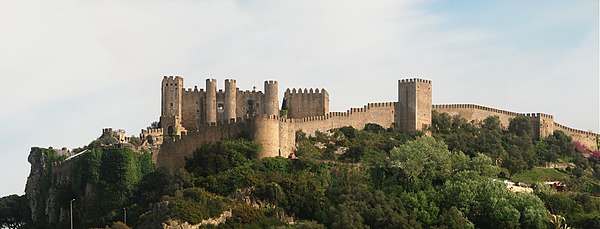Óbidos Municipality
Template:Geobox Óbidos is a municipality of 10,875 inhabitants (2001), in the Oeste Subregion of the Centro Region in continental Portugal (part of the older district of Leiria), its municipal seat is the town of Óbidos. The municipality covers an area of 141.55 km², bounded by in the northeast and east by Caldas da Rainha, in the south by Bombarral, in the southeast by Lourinhã, in the west by Peniche and fronting the Atlantic Ocean.
History

The origin of the municipality had its beginnings in an early Roman settlement near the foothills of an elevated escarpment. The region of Óbidos, that extended from the Atlantic to the interior of the Estremadura Province. along the rivers and lakes, has been inhabited since the late Paleolithic.[1] A settlement was constructed by early Celt tribes, that was later a centre of trade for the Phoenicians.[1] Archeological evidence from the base of the medieval tower (south of Facho) at Óbidos Castle indicates that evidence of Roman construction, that is linked to an outpot of the Roman civitas of Eburobrittium, a large urban area that has been under excavation.[1]
On 11 January 1148, the first king of Portugal, Afonso Henriques, supported by Gonçalo Mendes da Maia, took Óbidos from north African Arabs, after encircling their battlements.[1] Óbidos was then a Moorish outpost, protected by a pentagonal defensive line, but taken by the Portuguese it was a base for Templar raids.
With the gift of Óbidos, as a wedding gift between King Dinis and Queen Elizabeth, the settlement began to pertain to the Queen's patrimony; in fact, the village was referred to as the town of the Queens until 1834, since many of the royal consorts visited or stayed in Óbidos or regularly contributed funds to the settlement.[1] Queen Catherine constructed an aqueduct and fountain system during her stay.
Administrative reforms conducted by King Manuel I at Óbidos in 1513, included the institution of a formal charter and major requalification of the urban area.[1]
The 1755 earthquake caused damages to the walls of the village, a few temples and many buildings and resulting in the loss of Arab- or Medieval-inspire architecture.[1] Similarly, the Peninsular Wars were fought in the vicinity of Óbidos, including the Battle of Roliça, which was the liturgical centrer of the community.[1]
More recently, the village was a metro-pole and meeting place for those involved in the 1974 Carnation Revolution, linking it to the armed forces movement revolt.[1]
Geography
Administratively, the municipality is divided into nine civil parishes, that include:
Tourism
The town has a magnificent castle, now hosting a pousada. The municipality is also home to the well known and prestigious Praia D'el Rey golf complex, one of the top golf resorts in Europe.
References
- Notes
